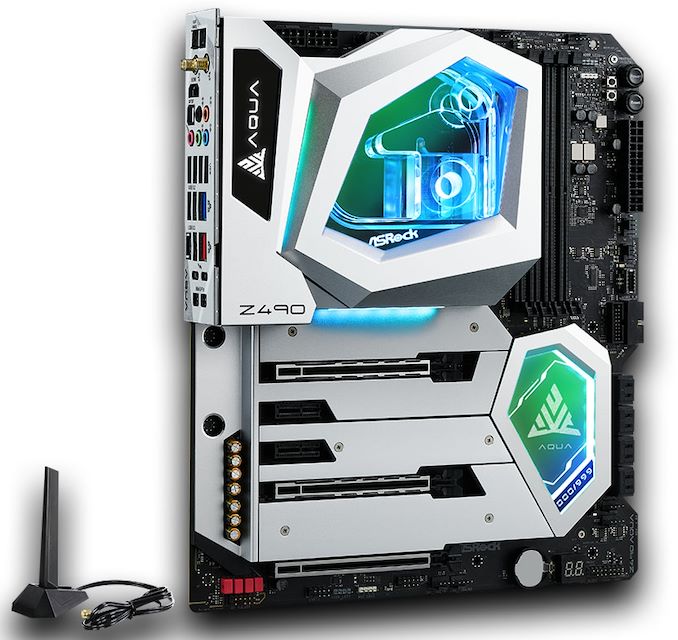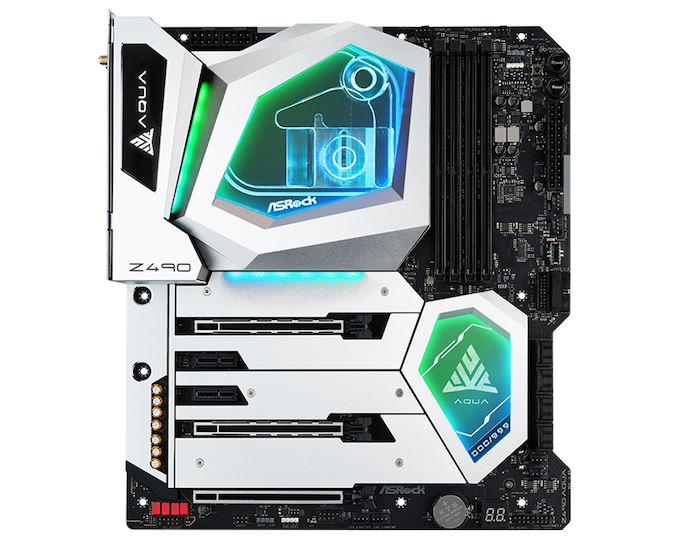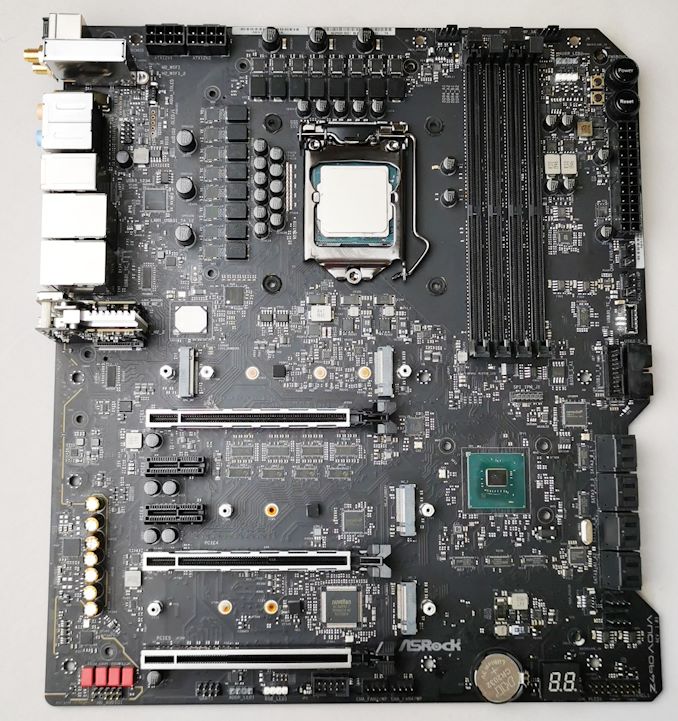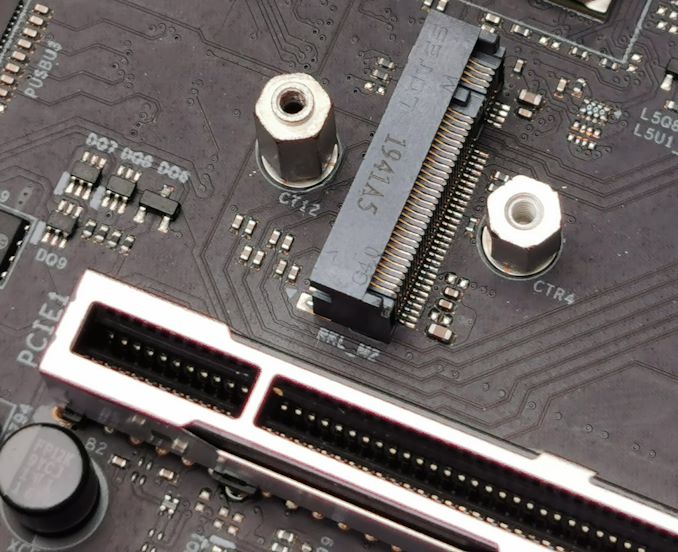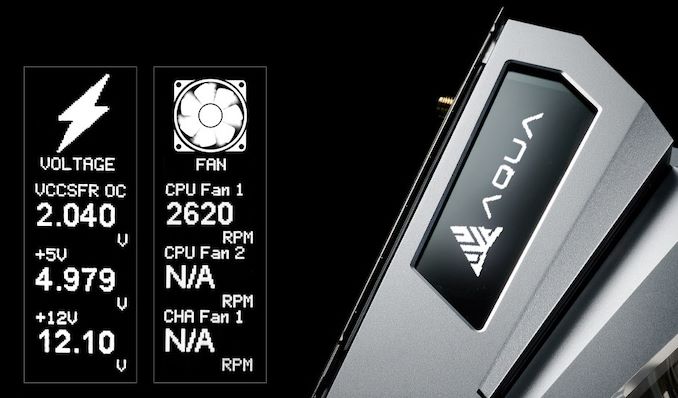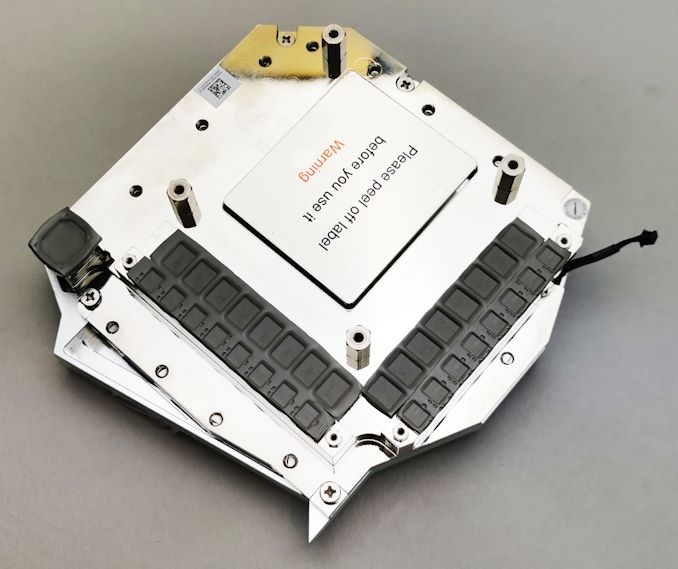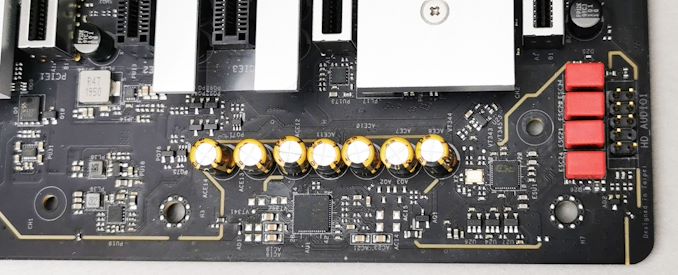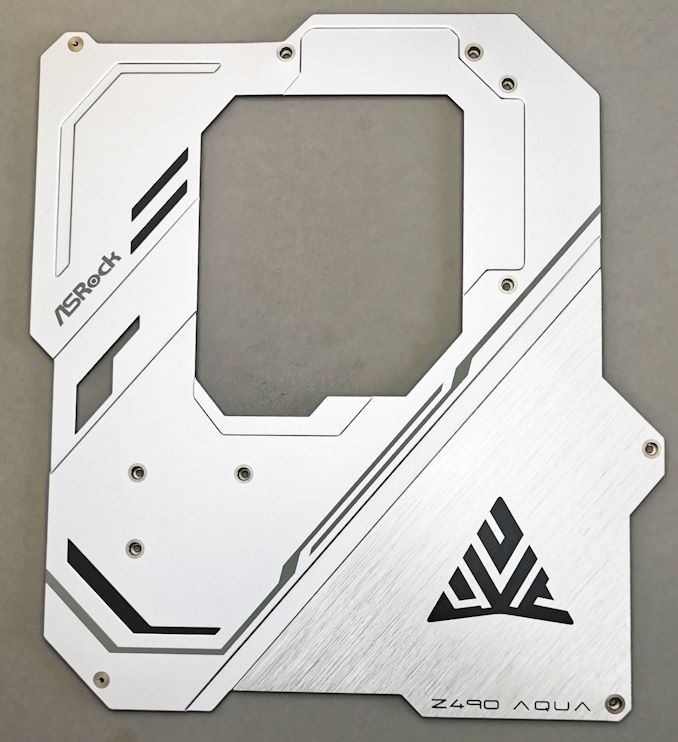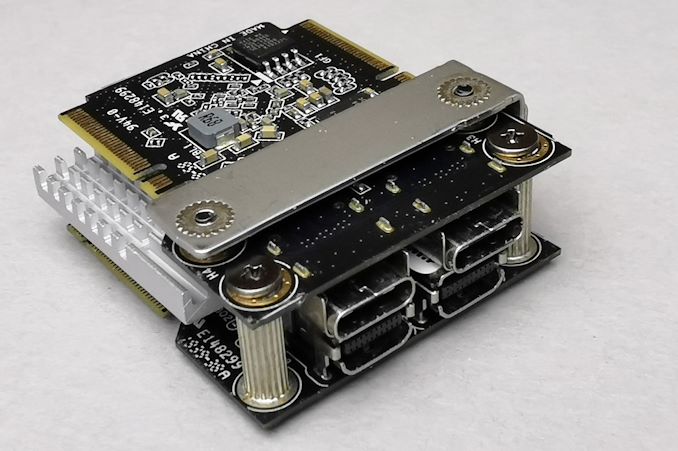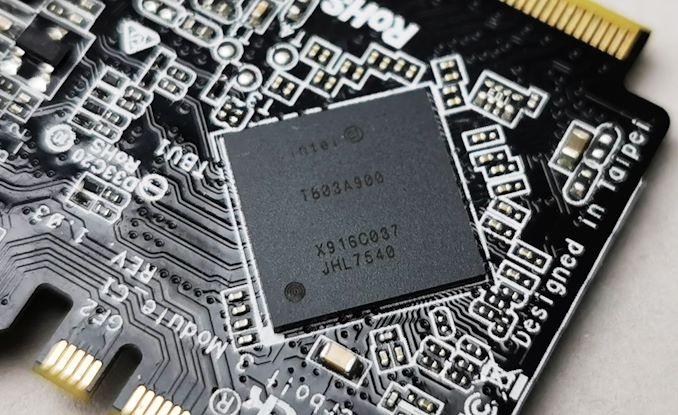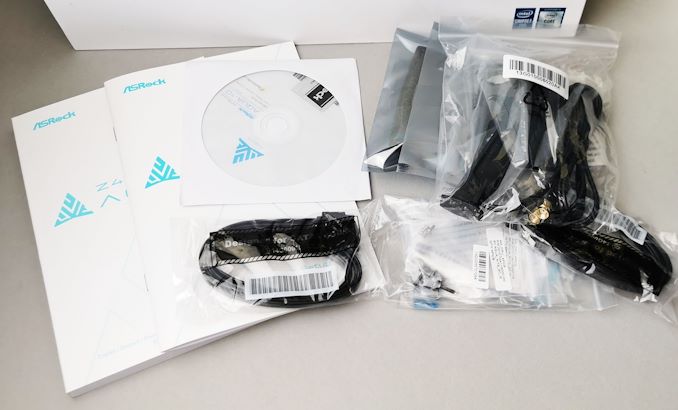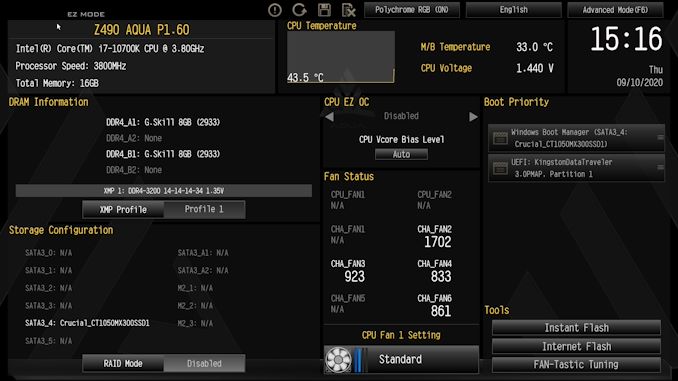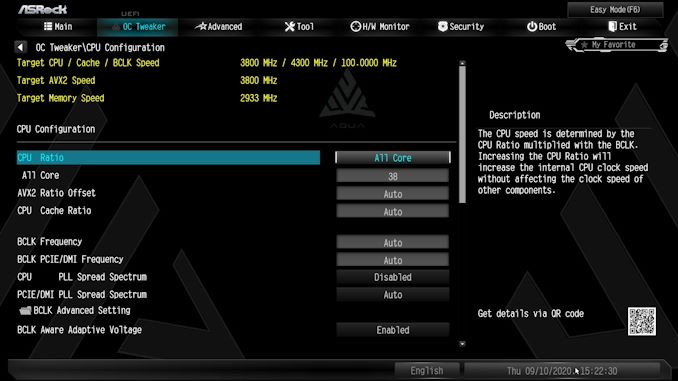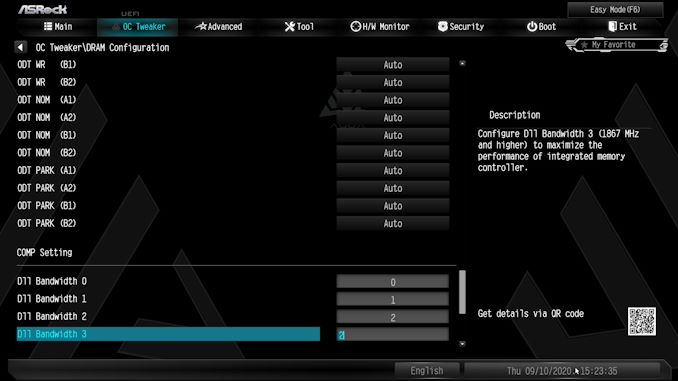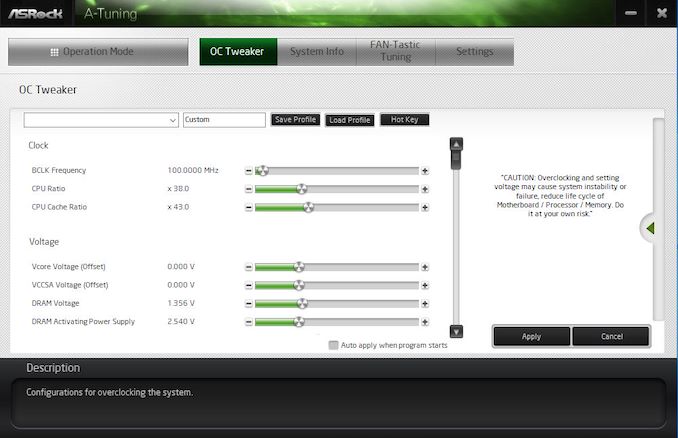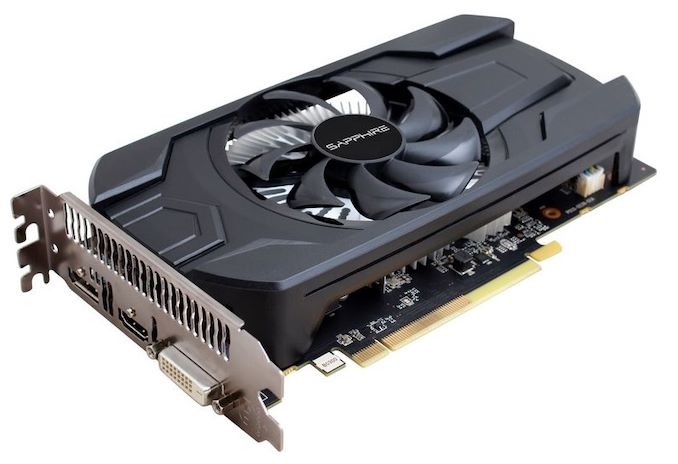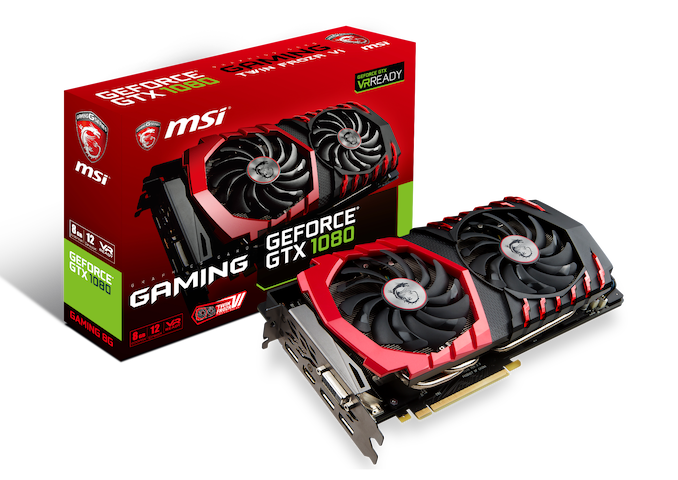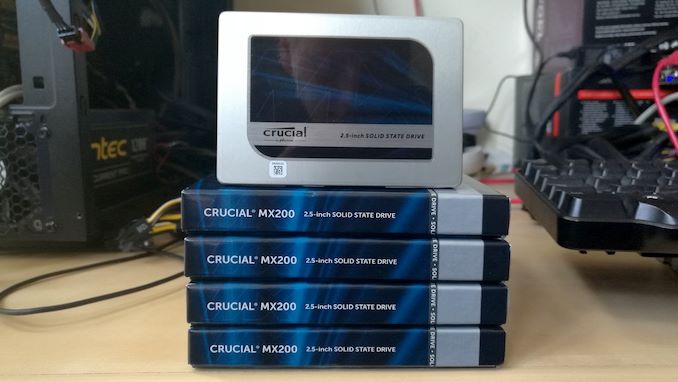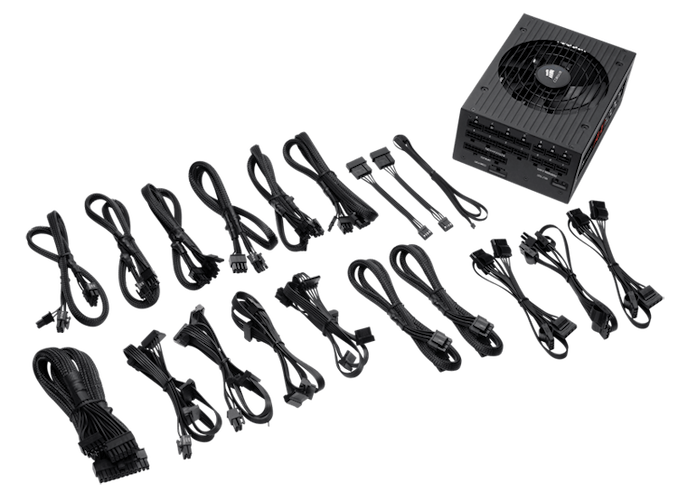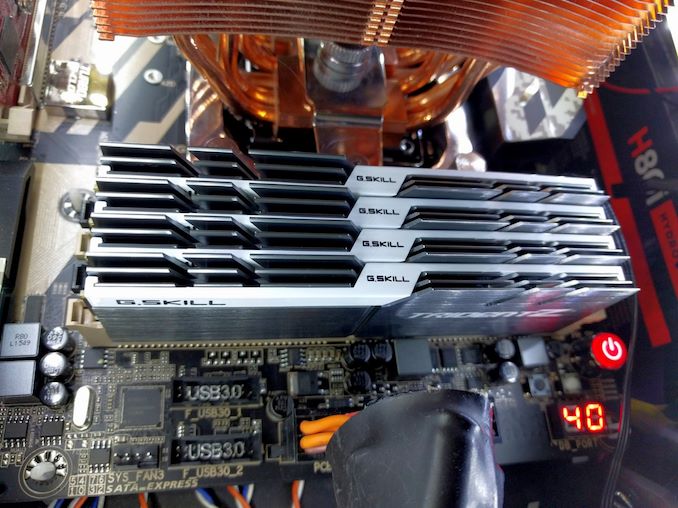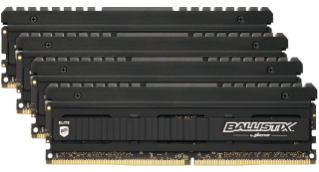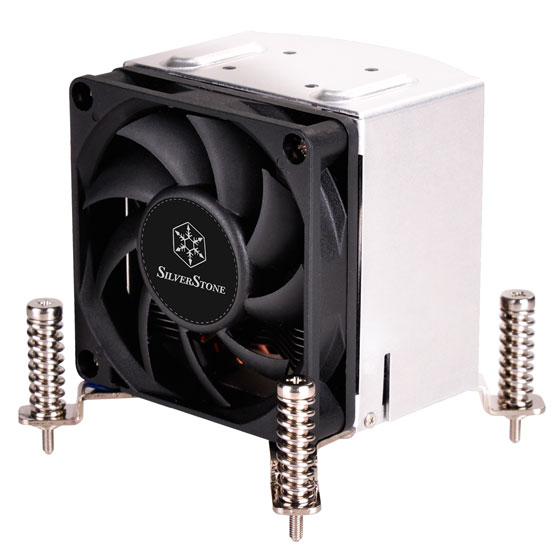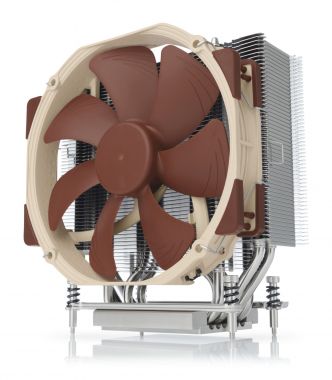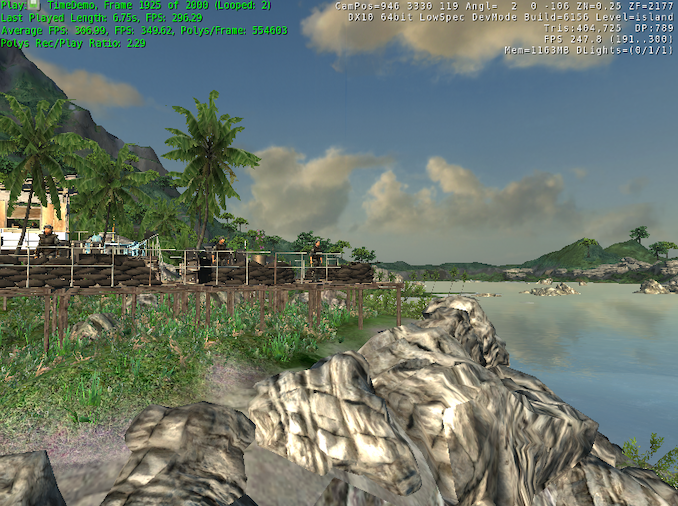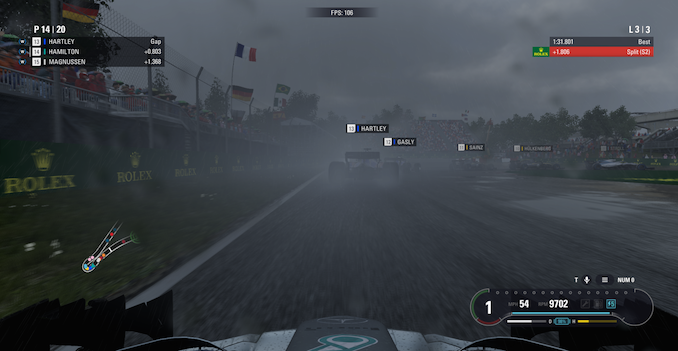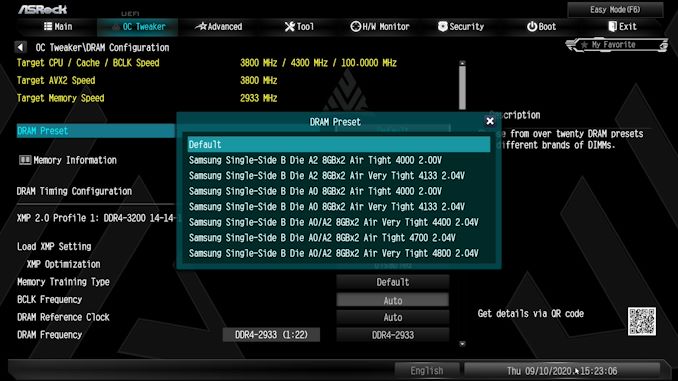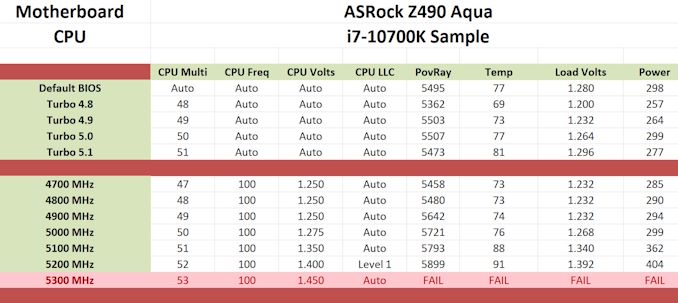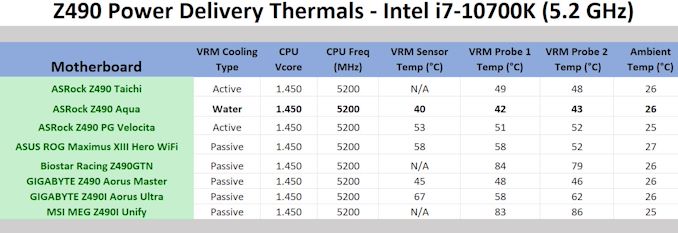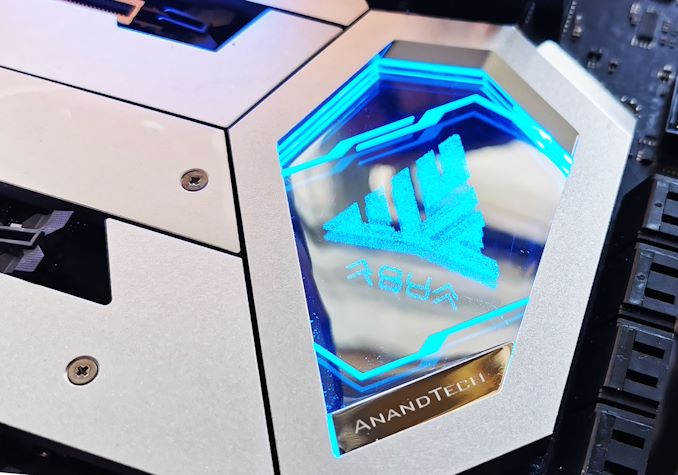
Original Link: https://www.anandtech.com/show/16023/the-asrock-z490-aqua-motherboard-review-
ASRock Z490 Aqua Motherboard Review: The $1100 LC Monoblock Flagship
by Gavin Bonshor on October 2, 2020 10:00 AM EST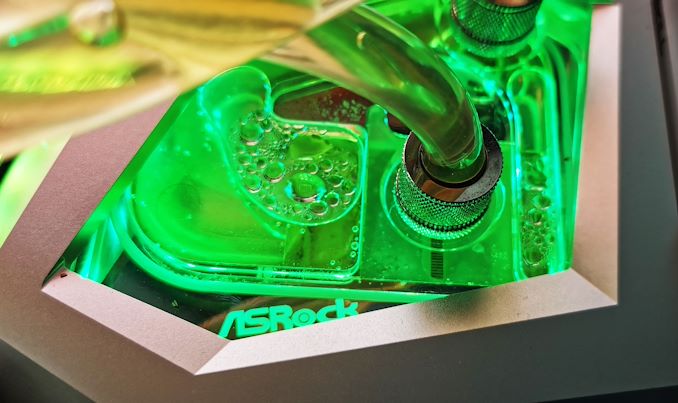
It is no secret that Intel's 10th generation processors are power-hungry. Intel has been squeezing every last drop of MHz out of the 14 nm process with its fastest desktop processors yet, but sometimes conventional air cooling just won't suffice for those wanting to push the limits even further. ASRock understands this, and building on the success of the elegant (yet wallet-emptying) AMD Aqua, the company unveiled an Intel version.
The Z490 Aqua comes equipped as a premium feature motherboard. The large integrated monoblock which cools both the CPU and the board's power delivery, amd it now features a very cool OLED display. There is also integrated Thunderbolt 3, 10 gigabit Ethernet, as well as its large 16-phase power delivery.
The Z490 Aqua: Time To Make a Splash
ASRock's highly premium and highly priced Z490 Aqua, on looks alone, exhudes over-engineering. As a marketing platform, over-engineering is a good thing, especially when the motherboard costs twice as much as the processor. From my perspective, the visual effect of the ASRock Z490 Aqua makes it one of the best-looking motherboards of all time. The design and implementation of its large CPU and VRM monoblock, with a seemingly endless amount of aluminum plating across the PCIe slot area, looks great. Not only that, but ASRock has included various areas of addressable RGB LEDs built onto the board, with an exquisite OLED panel that can display information ranging from CPU Voltage, CPU Temperature, and POST Status. It really sets it apart from the X570 Aqua we reviewed last year.
The ASRock Z490 Aqua is packed with features and appeal from top to bottom, with high-end enthusiasts using custom water cooling loops the primary target market. It includes one of the most premium desktop feature sets from any board we've seen from ASRock, with triple PCIe 3.0 x4 M.2 slots, eight SATA ports, and a solid networking array including a 10 gigabit Ethernet controller, with an additional 2.5 G port. An Intel-based Wi-Fi 6 CNVi provides both wireless networking and BT 5.1 capabilities, with an 8-layer PCB and 2 oz copper PCB for the board's finer circuitry.
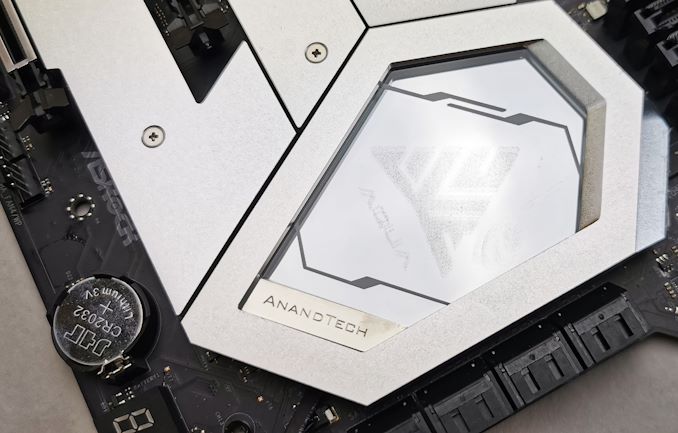
I got 99 problems, but an Aqua ain't one
Focusing on the power componentry of the Z490 Aqua, ASRock includes a large 16-phase power delivery, with fourteen premium 90A power stages for the CPU, with two 90A power stages for the SoC. It is cooled by the large custom monoblock, which is the board's main feature, which may be needed should users even attempt to use the power deliveries massive 1260 A current the CPU section is designed to deliver.
Another notable area is that the Z490 Aqua is well equipped in is connectivity, with an Intel Titan Ridge Thunderbolt 3 controller. This provides two 40 Gbps ports on the rear panel as well as with two mini DisplayPort inputs for users looking to leverage the multi-display capabilities of Thunderbolt 3. Also included are three additional USB 3.2 G2 Type-A and a single USB 3.2 G2 Type-C port, with four further USB 3.2 G1 Type-A ports. This is a lot of connectivity, so ASRock is trying to deliver on all areas with the Aqua, not just at enthusiasts and overclockers, but content creators too. ASRock also includes a premium audio solution with a separate DAC designed to boost users looking to use front panel audio.
In our test suite, the Aqua is very competitive with other Z490 models we have tested so far, with solid results in our DPC latency testing, which I will note is done at default settings with no OS tweaking. The figures in our power testing were a little more than normal in the idle power states, but the Aqua has lots of controllers and RGB, so it's easy to see why. In the computation and gaming tests, the Aqua showed no gaping flaws and was consistent with other boards in our charts.
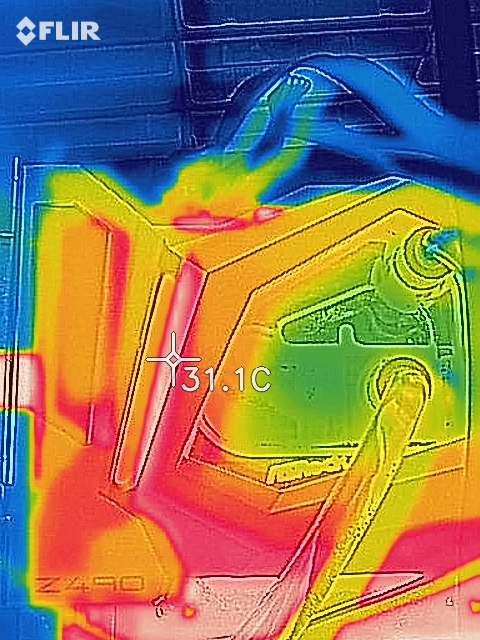
The ASRock Z490 Aqua under a thermal imaging camera
It's no surprise with all the bells and whistles it has, that the Aqua is an overclocking stud. The Aqua has solid VDroop control, which is likely due to ASRock's firmware, which reverts the loadline calibration profile to level 1 when any alterations to the CPU VCore are made. Although we didn't manage to push our i7-10700K beyond 5.3 GHz stable, which seems to be the limit of our silicon, we did see much better temperatures and no thermal throttling at 5.2 GHz, unlike other models we have tested. This is all down to the cooling, custom loop. The large monoblock cools both the CPU and the monolithic power delivery, which shows up well in our VRM thermal testing, and puts the Aqua a cut above the rest regarding thermal performance.
In regards to competitors, there isn't much on the market that competes with the all-round nature of the ASRock Z490 Aqua, especially with its custom monoblock. There are only a couple of Z490 models with monoblocks, namely GIGABYTE's X570 Aorus Xtreme WaterForce, which costs a whopping $1300, and the more affordable, albeit less premium, MSI MPG Z490 Carbon EK X ($400). ASRock's Aqua retails for $1100, which is around $200 cheaper than the GIGABYTE but still includes some very premium aspects that a board of this pedigree should include. ASRock also sweetens the deal with very attractive packaging, and an included Aqua themed set of water cooling fittings in the accessories bundle. It should be noted that only 999 of these boards will be made available to the consumer, and being limited edition has its perks, but this does come at a price, $1100, to be exact.
The question then becomes if you really want a motherboard that costs almost 2x of the overclockable Core i9 parts. For system integrators looking to build the most premium Z490 platform system, it makes sense. For companies that employ modders to show off hardware (such as liquid cooling, or power supplies, or DRAM), this also makes sense. For the average user? Read on for our extended analysis and comparison tests.
Visual Inspection
One of the most striking features of the ASRock Z490 Aqua is the large custom milled monoblock, which cools both the CPU and the power delivery. It is slightly larger than a conventional motherboard, with its E-ATX sized frame. Still, ASRock looks to have used every available inch of the PCB to offer one of the most premium desktop-based models it has ever developed. It is unique, and the aluminum style stretches across the board from head to toe, with plenty of integrated RGB LEDs, including zones in the middle of the monoblock where users can see the liquid flow, just above the PCIe area, and within the chipset heatsink. In fact, this resembles the ASRock X570 Aqua, which we previously reviewed, but the Z490 version looks to have more 'oomph' about it in the aesthetics department.
Looking at an overall view of the board, the large monoblock dominates the top section, with four memory slots in the top right-hand corner. These slots can accommodate up to 128 GB of memory, with maximum speeds of up to DDR4-4700. Just to the right of the memory slots is a small 'overclockers toolkit', which consists of a power button, reset button, a safe boot, and an OC retry switch pairing.
Located around the PCB edging at various points, includes eight 4-pin headers, which are split into one for a CPU fan, one for an optional CPU fan or water pump, and six for chassis fans, although these can also house water pumps. Adding to the already stacked rear panel is plenty of connectivity with two USB 3.2 G1 headers which provide up to four additional Type-A ports, a single USB 2.0 header which can add two USB 2.0 ports, and a premium USB 3.2 G2 Type-C header which is appearing more regular on premium motherboards.
Focusing on the lower portion of the motherboard, this is where all the board's PCIe slot support is. The ASRock Z490 Aqua uses three full-length PCIe 3.0 slots, which operate at x16, x8/x8, and x8/x8/+x4, with a further two PCIe 2.0 x1 slots. These two slots are just under the first full-length PCIe slot, so a standard GPU will lose at least one - a larger card such as the new NVIDIA GeForce RTX3080/3090 cards with a 2.5 or 3 slot cooler will almost certainly make both unusable.
ASRock lists the first PCIe slot and the first M.2 slot as having the potential to support PCIe 4.0. This will be, we expect, when Intel launches it next generation processors. Still no ETA on those. What's even more interesting is that while ASRock says this board has three M.2 slots in total, we can count four in the picture above. There's a special one on the left:
This says RKL_M2, incidating that this is an additional M.2 slot for use when Rocket Lake is launched for the platform. There's also a 'G4.0' writing on it too. This RKL_M2 is built directly in line with the M.2_1 on the right, and as such they can't both be used with a 2280 M.2 drive at the same time. ASRock does not mention this 'extra' RKL M.2 slot in the online specifications, but it is interesting that they've decided to create a separate physical M.2 for Rocket Lake. We're confused as perhaps the M.2_1 is not wired for it? There is likely a mux in there to determine which one is in use as well.
For storage on Comet Lake, the Aqua has three PCIe 3.0 x4 M.2 slots, with the bottom two also including support for SATA drives. Touching on SATA, there are a total of eight ports, with six driven by the chipset with support for RAID 0, 1, 5, and 10 arrays, while an ASMedia ASM1061 SATA controller powers the other two. All of the SATA ports support ACHI and hot plugging.
Integrated into the rear panel cover is a nifty OLED screen that can display multiple aspects, including POST status, current voltages, fan speed, and CPU/VRM temperatures. These variables can be customized in the firmware, and it gives a visual aid for any errors during POST, such as memory or VGA failures. Unfortunately, this cannot be customized to include custom GIFs or images, but it's a lot more premium than a standard two-digit LED POST, which ASRock does also include in the bottom right-hand corner of the board.
Underneath the custom aluminum monoblock is a highly overkill power delivery, designed for maximum performance. The Z490 Aqua is packing some serious VRM weaponry with a 16-phase design, with fourteen Intersil ISL99390 90 A power stages for the CPU VCore, and two ISL99390 power stages for the SoC. It is using an Intersil ISL69296 PWM controller operating at 7+2, with the CPU section phases doubled up with seven ISL6617A doublers. In contrast, it's unlikely that regular users will use this power delivery's full capability, with a very large 1260A power draw for the CPU alone. Providing power to the power delivery is a pair of 8-pin 12 V ATX connectors.
Cooling the CPU and power delivery is the large custom Aqua water block, with an inlet and outlet, and comes preinstalled on the board when purchased. The power delivery area includes a pre-applied set of thermal pads, with some spares included in the box should any mishaps happen during installation. It should be noted that it's pretty heavy, and the mounting pressure to the power delivery and the CPU socket area seems solid - we had no issues, however we have noted that a couple of users online seem to be having some trouble. For reference, the most northerly G1/4 threaded connector is the outlet, while the one underneath is the inlet.
The monoblock is actually mostly copper, with an aluminium plating on the top and a nickel base on the bottom. Overall the mount and the design feels a lot more refined than the AMD Aqua model, and clearly an improved version.
The audio PCB includes an array of capacitors and chips, all of which centers around the Realtek ALC1220 HD audio codec, which does all of the onboard audio processing. Complementing this is a total of seven gold Japanese Nichicon capacitors, with four WIMA audio capacitors. Designed to bolster the quality of the front panel audio header, ASRock includes an ESS SABRE9218 DAC. The audio componentry is also separated from the rest of the board's PCB, although the audio codec doesn't include any EMI shielding.
On the board's rear is a large aluminum backplate with Aqua branding towards the bottom right-hand side. This is designed to provide extra stability and rigidity to the board's structure. The monoblock itself is heavy, let alone any other components such as VGA or expansion cards are installed. It also includes thermal pads for the back of the power delivery, which allows the backplate to potentially aide in cooling them instead of choking them.
The rear panel has plenty of connectivity, which boasts two USB Type-C Thunderbolt 3 ports, which double up as USB 3.2 G2 Type-C 20 Gbps ports. Also featured are three USB 3.2 G2 Type-A, with four USB 3.2 G1 Type-A ports, and a single USB 3.2 G2 Type-C port, as well as a single HDMI video output for users looking to use integrated graphics, however unlikely with a board of this caliber. Also present is a pair of mini DisplayPort inputs, which expands the board's Thunderbolt 3 capabilities, The five 3.5 mm a Realtek ALC1220 HD audio codec powers audio jacks and S/PDIF optical output. At the same time, the board also includes a clear CMOS and BIOS Flashback switch pairing. Finishing off the rear panel is a trifecta of premium grade networking, with one RJ45 port driven by an Aquantia AQC107 10 gigabit Ethernet controller, the second by a Realtek RTL8125BG 2.5 gigabit Ethernet controller, and two antenna connectors for use with the Intel AX201 Wi-Fi 6 interface which also adds BT 5.1 connectivity.
The Thunderbolt 3 is on the far right on the IO ports, with two DisplayPort inputs and two Type-C outputs.
This is what the module looks like on the inside, and we can confirm it is using the JHL7540 Titan Ridge Controller.
What's in The Box
The ASRock Z490 Aqua includes a stacked accessories bundle with everything in the box to get a system up and running. This includes four SATA cables, an ASRock SLI two-slot adapter, spare thermal pads, a thermal compound tube, three M.2 installation screws, and an Intel AX201 Wi-Fi 6 interface antenna.
Perhaps the star of the included accessories show is a pack of custom Aqua branded water cooling fittings. These are all G1/4 fittings, with support for 14 mm OD tubing. Included are six straight fittings, four 90 degree angled fittings, two G1/4 plugs, and a ball valve. The entire package of the Aqua screams premium, and that's to be expected given the board's $1100 MSRP.
- 4 x SATA cables
- ASRock SLI HB bridge (two slots)
- Intel AX201 Wi-Fi 6 antenna
- Tube of thermal compound
- 5 x Spare thermal pads
- 4 x Spare screws for the power delivery area
- 4 x Spare screws for the CPU socket
- 2 x 90 degree G1/4 to 14 mm tube fittings
- 6 x G1/4 to 14mm straight tube fittings
- 2 x G/14 plugs
- Ball valve
- 3 x M.2 screws
- 2 x M.2 standoffs
BIOS
A lot of the following analysis comes from our ASRock Z490 PG Velocita review due to the near-identical firmware and software package the Z490 Aqua is supplied with.
The ASRock Z490 Aqua uses a near-identical BIOS to the ASRock Z490 PG Velocita, which we previously reviewed; the most notable difference is in the memory (DRAM) section, with some preset memory overclocking profiles designed for enthusiasts and extreme overclockers looking to eke out that extra percentage for benchmarking. Aside from memory, the board uses a custom Aqua skinned GUI, with a yellow, grey, and black color scheme.
ASRock's UEFI BIOS for Z490 has two primary modes, basic and advanced. Focusing on the basic mode, it provides a quite comprehensive list of information across the entirety of the screen. From top to bottom, there's information for the installed processor, the version of firmware the board is using, as well as a list of installed memory including its speed. . On the right-hand side is a boot priority listing in which users can click and drag the desired boot order, with one-click access to ASRock's Instant Flash, Internet Flash, and FAN-Tastic Tuning tools.
Upon pressing the F6 key will alternate between the basic and advanced modes, with the latter including the vast majority of the board's firmware features. The most comprehensive section is the advanced section with multiple menus, including the OC Tweaker, Advanced, Tool, H/W Monitor, Security, Boot, and Exit. Each of these is self-explanatory, but perhaps the busiest area is in the OC Tweaker section, where all overclocking settings reside. The OC Tweaker section allows users to overclock the CPU, memory, and integrated graphics onboard Intel's Comet Lake processors. Users can simply enable the built-in X.M.P 2.0 profiles onboard compatible memory or use ASRock preset memory profiles, which cater more towards performance users and enthusiast overclockers.
ASRock separates the settings into different sub-menus, including a dedicated section for CPU, voltage, and DRAM settings. Each submenu provides a wide variety of options, with CPU ratio and BCLK adjustments, as well as CPU AVX rations all available to customize. The CPU section also hosts all the relevant power settings for Intel Thermal Velocity Boost and Turbo and Speedstep settings. The DRAM section allows users to overclock memory and tweak latencies, with a one-click button for users looking to keep things simple and enable X.M.P 2.0 memory profiles. The voltage section includes all of the voltages, including CPU VCore, DRAM Voltage, and the customization of other voltages such as PLL, PCH, and VCCIO.
The ASRock Z490 Aqua's firmware is typical from the brand and is consistent throughout its Z490 models. It is easy to navigate, and although splitting each of the overclocking menus into CPU, DRAM, and Voltage, it keeps things tidy. As I noted in our previous review of the ASRock Z490 PG Velocita, I would personally prefer to see them located within the same menu for ease of use, without the need to constantly cycle different menus sub-menus to change core settings such as CPU frequency and CPU VCore voltage. The Aqua's integrated ASRock Polychrome RGB utility and Fan-Tastic fan tuning functionality within the firmware is a nice touch. Still, the software package does offer more on-the-fly customizability.
Software
Supplied with the ASRock Z490 Aqua is a varied selection of software. The most prominent applications include the A-Tuning overclocking utility, which despite the Aqua's uniqueness, doesn't get treated to a custom GUI and instead opts for a basic skinned variant. A-Tuning allows users to alter both CPU and BCLK frequencies within Windows and make alterations to CPU and CPU Cache ratios and primary core voltage settings.
Other useful utilities include the ASRock Polychrome RGB utility for customizing the integrated RGB LEDs around the board, with its handy App Shop and Live Update tool, as well as Nahamic 3 for audio customizations. Users can install the software from the disc included within the accessories bundle, or download the latest versions from the Live App utility or the official product page on the ASRock website.
Board Features
The ASRock Z490 Aqua uses an E-ATX sized frame and is aimed at enthusiasts and users looking to run Intel's 10th Gen desktop processors with custom water cooling. Aside from the custom monoblock which cools the CPU, power delivery, and chipset, there are a large array of premium features, the highlights of which include an integrated Thunderbolt 3 controller and 10 gigabit Ethernet.
| ASRock Z490 Aqua E-ATX Motherboard | |||
| Warranty Period | 3 Years | ||
| Product Page | Link | ||
| Price | $1100 | ||
| Size | E-ATX | ||
| CPU Interface | LGA1200 | ||
| Chipset | Intel Z490 | ||
| Memory Slots (DDR4) | Four DDR4 Supporting 128 GB Dual-Channel Up to DDR4-4700 |
||
| Video | 1 x HDMI 2 x mDP (via TB3) |
||
| Network Connectivity | Aquantia AQC107 10 GbE Realtek RTL8125BG 2.5 GbE Intel AX201 Wi-Fi 6 |
||
| Onboard Audio | Realtek ALC1220 ESS Sabre9128 DAC (Front Panel) |
||
| PCIe Slots for Graphics (from CPU) | 2 x PCIe 3.0 (x16, x8/x8) | ||
| PCIe Slots for Other (from PCH) | 1 x PCIe 3.0 x4 2 x PCIe 2.0 x1 |
||
| Onboard SATA | Six, RAID 0/1/5/10 (Z490) Two, (ASMedia) |
||
| Onboard M.2 | 1 x PCIe 3.0 2 x PCIe 3.0 x4/SATA |
||
| Thunderbolt 3 | 2 x USB Type-C (Rear panel) | ||
| USB 3.2 (20 Gbps) | None | ||
| USB 3.2 (10 Gbps) | 3 x USB Type-A (Rear panel) 1 x USB Type-C (Rear panel) 2 x USB Type-C (via TB3) 4 x USB Type-A (Two headers) 1 x USB Type-C (One header) |
||
| USB 3.2 (5 Gbps) | 4 x USB Type-A (Rear panel) 4 x USB Type-A (Two headers) 1 x USB Type-C (One header) |
||
| USB 2.0 | 4 x USB Type-A (Two headers) | ||
| Power Connectors | 1 x 24-pin Motherboard 2 x 8-pin CPU |
||
| Fan Headers | 1 x 4-pin CPU 1 x 4-pin CPU/Water pump 6 x 4-pin Chassis |
||
| IO Panel | 1 x PS/2 Mouse/Keyboard 1 x HDMI output 2 x USB Type-C (Thunderbolt 3) 3 x USB 3.2 G2 Type-A 1 x USB 3.2 G2 Type-C 4 x USB 3.2 G1 Type-A 1 x RJ45 (Aquantia) 1 x RJ45 (Realtek) 5 x 3.5 mm audio jacks (Realtek) 1 x S/PDIF Optical output (Realtek) |
||
On the rear panel is an array of input and output with two very fast Type-C connectors due to the inclusion of an Intel Thunderbolt 3 controller. ASRock also includes two mini-DisplayPort inputs for users looking to leverage Thunderbolt 3's video capabilities. Other notable connections include a pair of Ethernet ports with one driven by an Aquantia AQC107 10 G controller and the other by a Realtek RTL8125BG 2.5 G controller. There's also a wireless capability with a pre-installed Intel AX201 Wi-Fi 6 and BT 5.1 CNVI interface. Other prominent features include an overclockers toolkit with a power, reset, and clear CMOS switch, as well as and OLED status light. The impressive OLED screen on the rear panel cover, unfortunately, cannot be customized with GIFs or images. For cooling, the Z490 Aqua includes eight 4-pin headers, with one designated to a CPU fan, one for an optional CPU fan or water pump, with six for chassis fans.
Test Bed
As per our testing policy, we take a high-end CPU suitable for the motherboard that was released during the socket’s initial launch and equip the system with a suitable amount of memory running at the processor maximum supported frequency. This is also typically run at JEDEC subtimings where possible. It is noted that some users are not keen on this policy, stating that sometimes the maximum supported frequency is quite low, or faster memory is available at a similar price, or that the JEDEC speeds can be prohibitive for performance. While these comments make sense, ultimately very few users apply memory profiles (either XMP or other) as they require interaction with the BIOS, and most users will fall back on JEDEC supported speeds - this includes home users as well as industry who might want to shave off a cent or two from the cost or stay within the margins set by the manufacturer. Where possible, we will extend out testing to include faster memory modules either at the same time as the review or a later date.
| Test Setup | |||
| Processor | Intel Core i7-10700K, 125 W, $374 8 Cores, 16 Threads 3.8 GHz (5.1 GHz Turbo) |
||
| Motherboard | ASRock Z490 Aqua (BIOS P1.60) | ||
| Cooling | Corsair HydroX Custom Loop (360 mm radiator) | ||
| Power Supply | Corsair HX850 850 W 80 PLUS Platinum | ||
| Memory | G.Skill 2x8 GB TridentZ DDR4-2933 | ||
| Video Card | MSI GTX 1080 (1178/1279 Boost) | ||
| Hard Drive | Crucial MX300 1TB | ||
| Case | Open bench Table (OBT) | ||
| Operating System | Windows 10 1909 inc. Spectre/Meltdown Patches | ||
Readers of our motherboard review section will have noted the trend in modern motherboards to implement a form of MultiCore Enhancement / Acceleration / Turbo (read our report here) on their motherboards. This does several things, including better benchmark results at stock settings (not entirely needed if overclocking is an end-user goal) at the expense of heat and temperature. It also gives, in essence, an automatic overclock which may be against what the user wants. Our testing methodology is ‘out-of-the-box’, with the latest public BIOS installed and XMP enabled, and thus subject to the whims of this feature. It is ultimately up to the motherboard manufacturer to take this risk – and manufacturers taking risks in the setup is something they do on every product (think C-state settings, USB priority, DPC Latency / monitoring priority, overriding memory sub-timings at JEDEC). Processor speed change is part of that risk, and ultimately if no overclocking is planned, some motherboards will affect how fast that shiny new processor goes and can be an important factor in the system build.
System Performance
Not all motherboards are created equal. On the face of it, they should all perform the same and differ only in the functionality they provide - however, this is not the case. The obvious pointers are power consumption, POST time and latency. This can come down to the manufacturing process and prowess, so these are tested.
For Z490 we are running using Windows 10 64-bit with the 1909 update.
Power Consumption
Power consumption was tested on the system while in a single MSI GTX 1080 Gaming configuration with a wall meter connected to the power supply. This power supply has ~75% efficiency > 50W, and 90%+ efficiency at 250W, suitable for both idle and multi-GPU loading. This method of power reading allows us to compare the power management of the UEFI and the board to supply components with power under load, and includes typical PSU losses due to efficiency. These are the real-world values that consumers may expect from a typical system (minus the monitor) using this motherboard.
While this method for power measurement may not be ideal, and you feel these numbers are not representative due to the high wattage power supply being used (we use the same PSU to remain consistent over a series of reviews, and the fact that some boards on our testbed get tested with three or four high powered GPUs), the important point to take away is the relationship between the numbers. These boards are all under the same conditions, and thus the differences between them should be easy to spot.
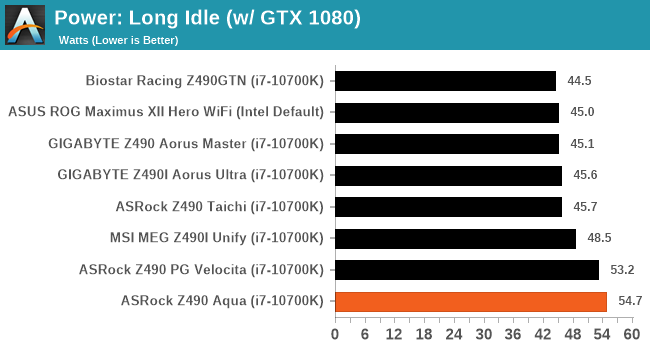
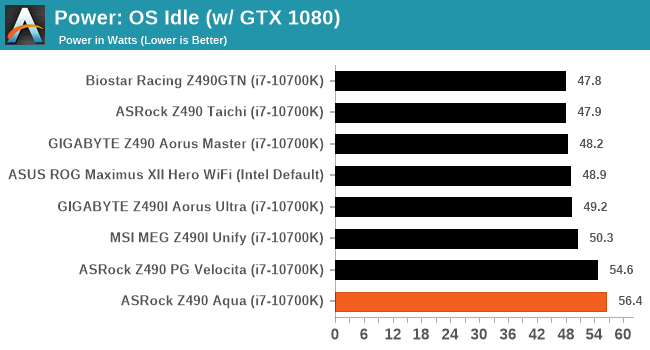
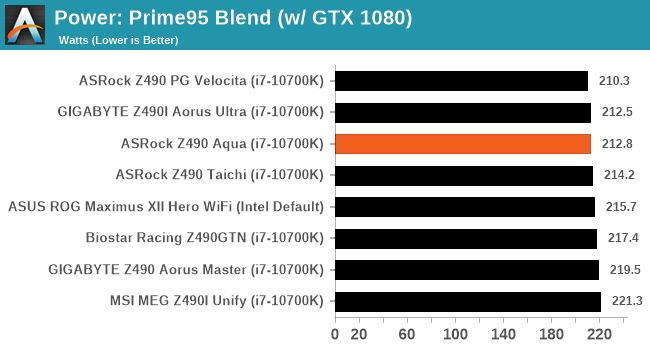
The ASRock uses slightly more power in both the idle and long idle power states, but this could be due to all of the boards RGB, the OLED screen, and the sheer number of controllers. At full load, the Aqua performs very competitively with a maximum power figure of 212.8 W.
Non-UEFI POST Time
Different motherboards have different POST sequences before an operating system is initialized. A lot of this is dependent on the board itself, and POST boot time is determined by the controllers on board (and the sequence of how those extras are organized). As part of our testing, we look at the POST Boot Time using a stopwatch. This is the time from pressing the ON button on the computer to when Windows starts loading. (We discount Windows loading as it is highly variable given Windows specific features.)
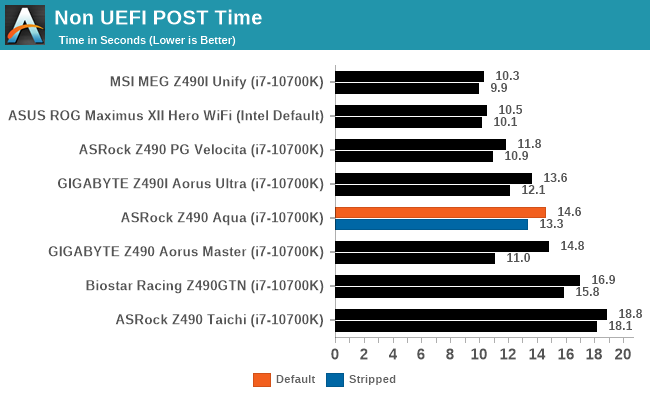
In our POST time testing, the Aqua sits middle of the road, although, with all of the nonessential controllers disabled, we got the time down to 13.3 seconds which is quicker than some boards boot at with them enabled.
DPC Latency
Deferred Procedure Call latency is a way in which Windows handles interrupt servicing. In order to wait for a processor to acknowledge the request, the system will queue all interrupt requests by priority. Critical interrupts will be handled as soon as possible, whereas lesser priority requests such as audio will be further down the line. If the audio device requires data, it will have to wait until the request is processed before the buffer is filled.
If the device drivers of higher priority components in a system are poorly implemented, this can cause delays in request scheduling and process time. This can lead to an empty audio buffer and characteristic audible pauses, pops and clicks. The DPC latency checker measures how much time is taken processing DPCs from driver invocation. The lower the value will result in better audio transfer at smaller buffer sizes. Results are measured in microseconds.
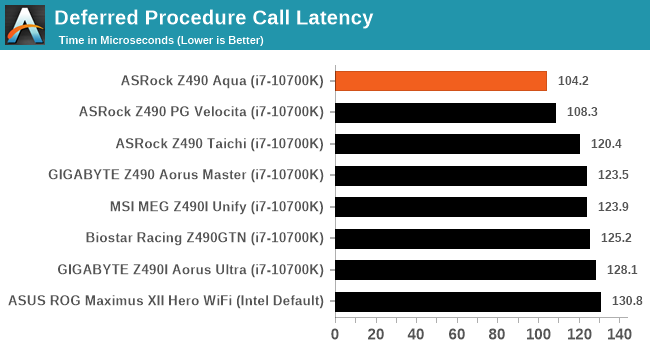
We test DPC latency out of the box with default settings, and the Aqua performs very well, even better than the Velocita PG, and knocks it off the top spot with relative ease.
CPU Performance, Short Form
For our motherboard reviews, we use our short form testing method. These tests usually focus on if a motherboard is using MultiCore Turbo (the feature used to have maximum turbo on at all times, giving a frequency advantage), or if there are slight gains to be had from tweaking the firmware. We put the memory settings at the CPU manufacturers suggested frequency, making it very easy to see which motherboards have MCT enabled by default.
For Z490 we are running using Windows 10 64-bit with the 1909 update.
Update: A Note About Z490 and Turbo
Normally we test our motherboards with out of the box settings. This means that the performance will get boosted based on whatever default algorithm each motherboard vendor implements with regards turbo time and boost power. Intel actively encourages this - the numbers it puts in for turbo time and turbo power are recommendations, rather than specifications, and Intel wants motherboard vendors to engineer their products to the turbo and power that each vendor deems acceptable for their product. As a result, a lot of motherboards will implement an aggressive turbo algorithm.
For this generation, ASUS has done something different. ASUS' enthusiast motherboards offer two different options on first boot: Intel recommendations, or ASUS recommendations. This means that there is a small performance delta between the two, especially for ASUS' high-end motherboards. ASUS has put this into the product based on customer feedback and how motherboard vendors have slowly drifted over the last decade to well beyond what Intel recommends.
For our testing methodology, we try to leave as much as we can on default, because this is part of what makes a motherboard different to any other, and the motherboard vendor has to decide how aggressive it must be. Also, for non-enthusiasts who daren't enter the BIOS, or understand even what turbo or a CPU or what memory channels are, they will just end up with the non-XMP default settings. It is unclear what such a person might select when presented with the ASUS default option.
Rendering - Blender 2.7b: 3D Creation Suite
A high profile rendering tool, Blender is open-source allowing for massive amounts of configurability, and is used by a number of high-profile animation studios worldwide. The organization recently released a Blender benchmark package, a couple of weeks after we had narrowed our Blender test for our new suite, however their test can take over an hour. For our results, we run one of the sub-tests in that suite through the command line - a standard ‘bmw27’ scene in CPU only mode, and measure the time to complete the render.
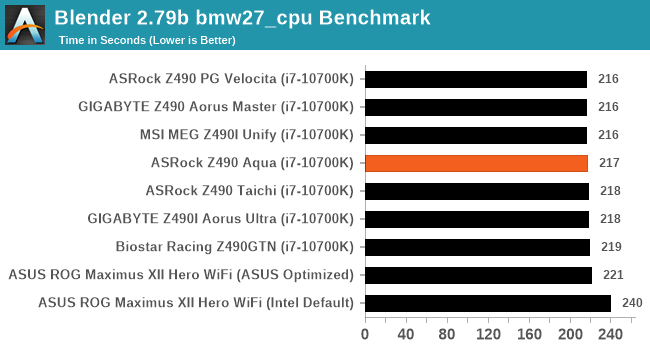
Rendering – POV-Ray 3.7.1: Ray Tracing
The Persistence of Vision Ray Tracer, or POV-Ray, is a freeware package for as the name suggests, ray tracing. It is a pure renderer, rather than modeling software, but the latest beta version contains a handy benchmark for stressing all processing threads on a platform. We have been using this test in motherboard reviews to test memory stability at various CPU speeds to good effect – if it passes the test, the IMC in the CPU is stable for a given CPU speed. As a CPU test, it runs for approximately 1-2 minutes on high-end platforms.
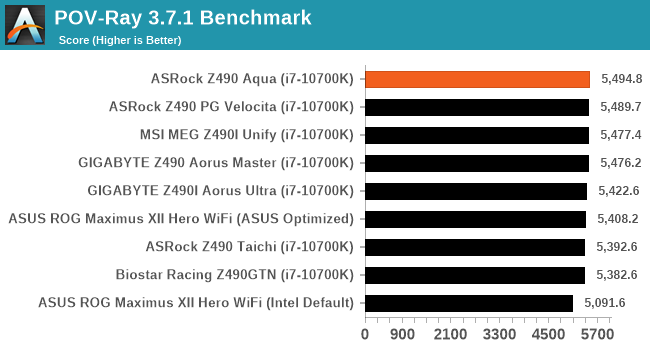
Rendering - Crysis CPU Render
One of the most oft used memes in computer gaming is ‘Can It Run Crysis?’. The original 2007 game, built in the Crytek engine by Crytek, was heralded as a computationally complex title for the hardware at the time and several years after, suggesting that a user needed graphics hardware from the future in order to run it. Fast forward over a decade, and the game runs fairly easily on modern GPUs, but we can also apply the same concept to pure CPU rendering – can the CPU render Crysis? Since 64 core processors entered the market, one can dream. We built a benchmark to see whether the hardware can.
For this test, we’re running Crysis’ own GPU benchmark, but in CPU render mode. This is a 2000 frame test, which we run over a series of resolutions from 800x600 up to 1920x1080. For simplicity, we provide the 1080p test here.
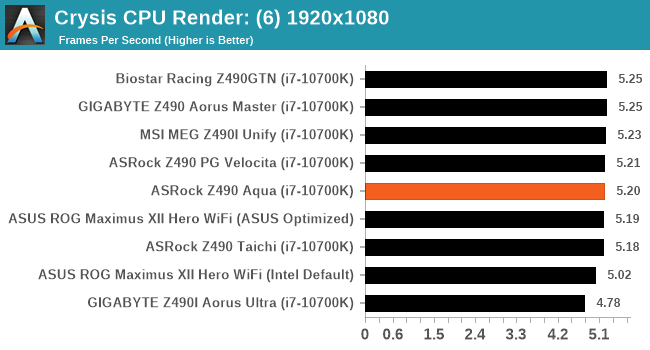
Point Calculations – 3D Movement Algorithm Test: link
3DPM is a self-penned benchmark, taking basic 3D movement algorithms used in Brownian Motion simulations and testing them for speed. High floating point performance, MHz, and IPC win in the single thread version, whereas the multithread version has to handle the threads and loves more cores. For a brief explanation of the platform agnostic coding behind this benchmark, see my forum post here.
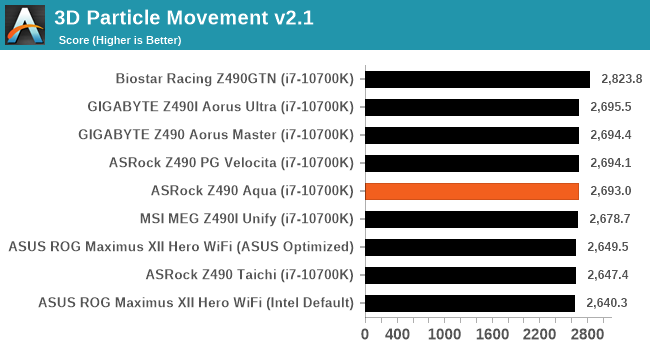
NAMD ApoA1
One frequent request over the years has been for some form of molecular dynamics simulation. Molecular dynamics forms the basis of a lot of computational biology and chemistry when modeling specific molecules, enabling researchers to find low energy configurations or potential active binding sites, especially when looking at larger proteins. We’re using the NAMD software here, or Nanoscale Molecular Dynamics, often cited for its parallel efficiency. Unfortunately the version we’re using is limited to 64 threads on Windows, but we can still use it to analyze our processors. We’re simulating the ApoA1 protein for 10 minutes, and reporting back the ‘nanoseconds per day’ that our processor can simulate. Molecular dynamics is so complex that yes, you can spend a day simply calculating a nanosecond of molecular movement.
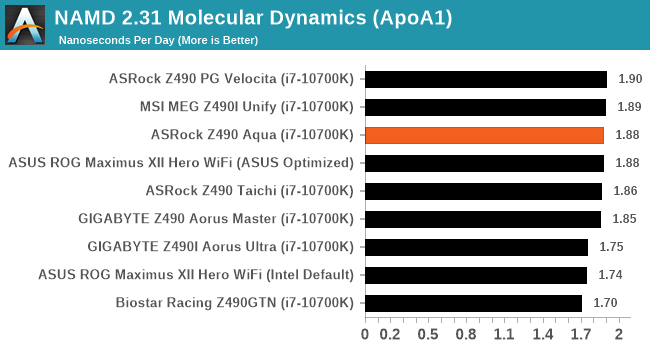
Gaming Performance
For Z490 we are running using Windows 10 64-bit with the 1909 update.
Grand Theft Auto V
The highly anticipated iteration of the Grand Theft Auto franchise hit the shelves on April 14th 2015, with both AMD and NVIDIA in tow to help optimize the title. GTA doesn’t provide graphical presets, but opens up the options to users and extends the boundaries by pushing even the hardest systems to the limit using Rockstar’s Advanced Game Engine under DirectX 11. Whether the user is flying high in the mountains with long draw distances or dealing with assorted trash in the city, when cranked up to maximum it creates stunning visuals but hard work for both the CPU and the GPU.
For our test we have scripted a version of the in-game benchmark. The in-game benchmark consists of five scenarios: four short panning shots with varying lighting and weather effects, and a fifth action sequence that lasts around 90 seconds. We use only the final part of the benchmark, which combines a flight scene in a jet followed by an inner city drive-by through several intersections followed by ramming a tanker that explodes, causing other cars to explode as well. This is a mix of distance rendering followed by a detailed near-rendering action sequence, and the title thankfully spits out frame time data.
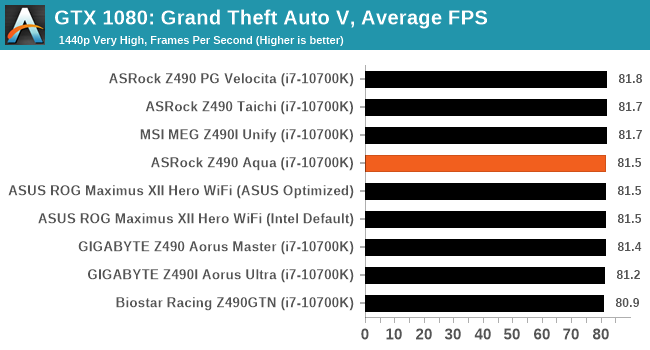
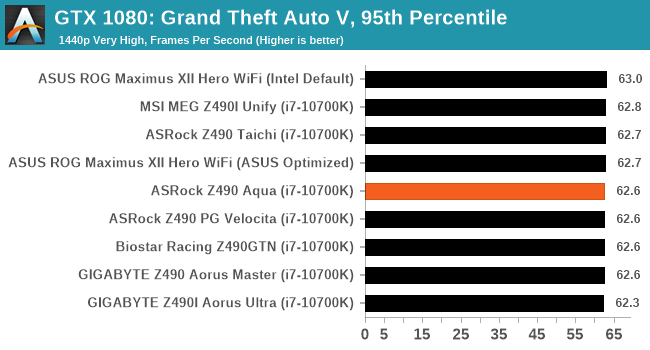
F1 2018
Aside from keeping up-to-date on the Formula One world, F1 2017 added HDR support, which F1 2018 has maintained; otherwise, we should see any newer versions of Codemasters' EGO engine find its way into F1. Graphically demanding in its own right, F1 2018 keeps a useful racing-type graphics workload in our benchmarks.
Aside from keeping up-to-date on the Formula One world, F1 2017 added HDR support, which F1 2018 has maintained. We use the in-game benchmark, set to run on the Montreal track in the wet, driving as Lewis Hamilton from last place on the grid. Data is taken over a one-lap race.
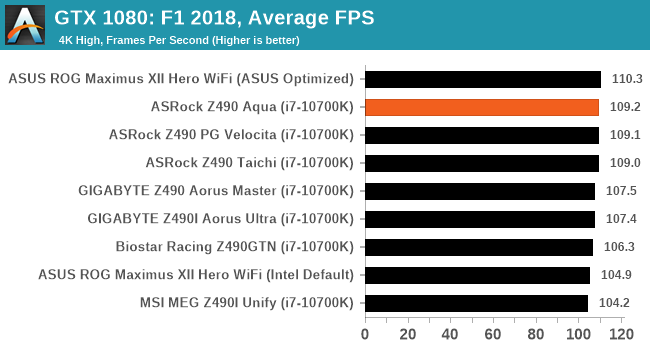
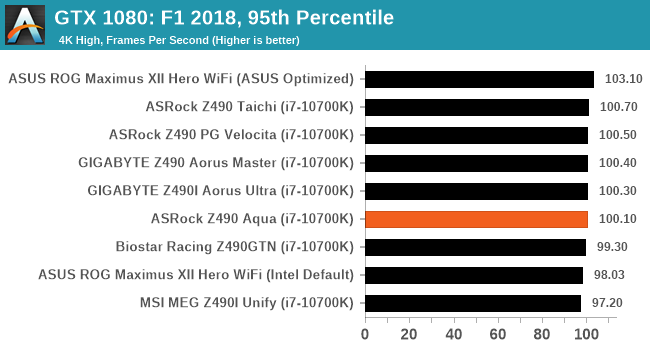
Strange Brigade (DX12)
Strange Brigade is based in 1903’s Egypt and follows a story which is very similar to that of the Mummy film franchise. This particular third-person shooter is developed by Rebellion Developments which is more widely known for games such as the Sniper Elite and Alien vs Predator series. The game follows the hunt for Seteki the Witch Queen who has arose once again and the only ‘troop’ who can ultimately stop her. Gameplay is cooperative centric with a wide variety of different levels and many puzzles which need solving by the British colonial Secret Service agents sent to put an end to her reign of barbaric and brutality.
The game supports both the DirectX 12 and Vulkan APIs and houses its own built-in benchmark which offers various options up for customization including textures, anti-aliasing, reflections, draw distance and even allows users to enable or disable motion blur, ambient occlusion and tessellation among others. AMD has boasted previously that Strange Brigade is part of its Vulkan API implementation offering scalability for AMD multi-graphics card configurations.
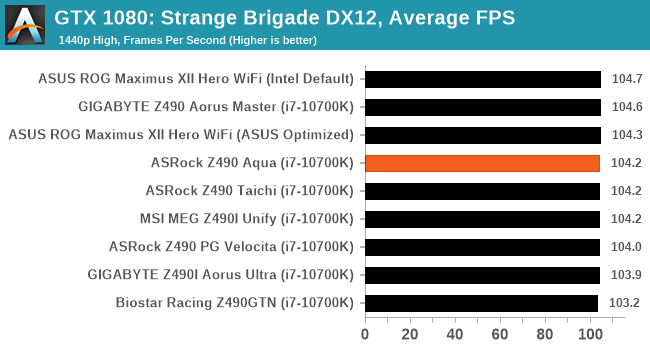
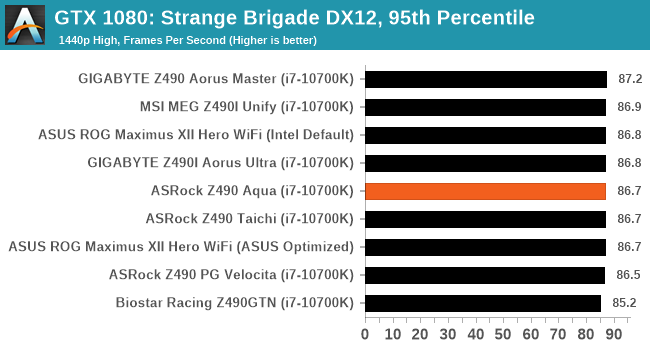
Overclocking
Experience with the ASRock Z490 Aqua
One of the common misconceptions when overclocking processors is that the cooler the CPU is, the faster it can run. To a degree, better and more aggressive cooling methods can certainly unlock extra potential and headroom when compared to conventional air tower coolers, but the biggest limitation is within the silicon itself. Due to the nature of how Intel's Comet Lake Desktop processors are binned, with aggressive turbo boosts such as Intel's Thermal Velocity Boost. processors are lucky to have much headroom at all.
Overclocking our Core i7-10700K testbed processor using the ASRock UEFI firmware was the same as other ASRock Z490 models we have tested. The OC Tweaker hosts all of the board's relevant overclock settings. ASRock has uniformed the main three areas into three sub-menus, CPU, DRAM, and Voltage. This makes specific settings easier to find, although it does mean a lot of switching between menus, so it's advisable for the sake of saving time to at least work out the variables, including CPU ratio, CPU VCore, and memory settings prior to changing them.
ASRock's firmware has a wide variety of different settings, with the CPU section within the OC Tweaker menu offering options to change the CPU ratio and BCLK ratio, as well as alter all of the CPU related power settings such as SpeedStep and the board's Thermal Velocity Boost settings. Within the DRAM section is the option to enable memory X.M.P 2.0 profiles, as well as sift through the copious amounts of memory latency settings. All of the board's voltage settings can be found under the voltage sub-menu, with some of the most notable including CPU VCore, VCCSA, DRAM, and CPU PLL voltage.
One of the most interesting overclocking features is the include ASRock memory profiles for different types of memory based on IC manufacturer and type. This includes specific presets for Samsung B-Die memory designed for different revisions of the IC's, including A2 and A0. These profiles are more geared towards sub-zero overclockers and users with high-binned memory, although looking at the DRAM Voltage of the profiles, these wouldn't be suitable for use in 24/7 settings, and more catered towards specific benchmarking runs.
Overclocking Methodology
Our standard overclocking methodology is as follows. We select the automatic overclock options and test for stability with POV-Ray and Prime95 to simulate high-end workloads. These stability tests aim to catch any immediate causes for memory or CPU errors.
For manual overclocks, based on the information gathered from the previous testing, starts off at a nominal voltage and CPU multiplier, and the multiplier is increased until the stability tests are failed. The CPU voltage is increased gradually until the stability tests are passed, and the process repeated until the motherboard reduces the multiplier automatically (due to safety protocol) or the CPU temperature reaches a stupidly high level (105ºC+). Our testbed is not in a case, which should push overclocks higher with fresher (cooler) air.
Overclocking Results
Included within the firmware with the ASRock Z490 Aqua is four overclocking presets which most vendors have avoided implementing on Z490; this is most likely due to the high turbo clock speeds on Comet Lake. There are profiles for 4.8, 4.9, 5.0, and 5.1 GHz, which all work well with custom loop cooling. The fastest of these profiles is 5.1 GHz, which operates with a load CPU VCore voltage of 1.296 V, which is very conservative compared to some vendors with its models.
Testing each of the overclocks manually ranging from 4.7 to 5.3 GHz, the first thing that became apparent was that water cooling didn't enable us to go further than 5.3 GHz on our i7-10700K silicon. We managed to boot into Windows at 5.3 GHz and 1.450 V on the CPU VCore, but it was very unstable and any load would crash the system. When changing the CPU VCore within the BIOS, the firmware would automatically revert the loadline calibration profile to level 1, which meant very tight VDroop and shows consistency between the VCore voltage set in the firmware, and the load voltage monitored at full load. For the first time, our overclock with our testbed processor ran 5.2 GHz without thermally throttling, but unfortunately, 5.3 GHz was just a stretch too far for the silicon.
As a natural consequence of feeding more CPU VCore into the CPU as we went up in frequency, we experienced more heat and power draw, although due to monoblock design, these temperatures were much better under full-load than conventional air/AIO coolers. The firmware itself is very stable and easy to use, with a robust selection of settings designed for overclockers and enthusiasts to get the most out of.
Power Delivery Thermal Analysis
A lot more focus has been put onto power delivery specifications and capabilities, not just by manufacturers, but as a result of users demands. In addition to the extra power benefits from things like overclocking, more efficient designs in power deliveries and cooling solutions aim to bring temperatures down. Although this isn't something most users ever need to worry about, certain enthusiasts are bringing more focus onto each boards power delivery. The more premium models tend to include bigger and higher-grade power deliveries, with bigger and more intricate heatsink designs, with some even providing water blocks, like the Aqua.
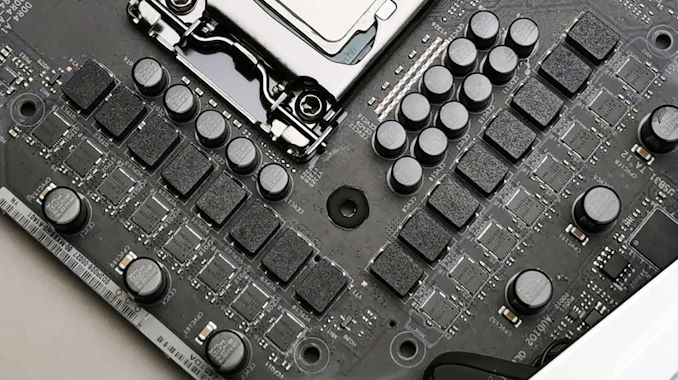
The 14+2 power delivery on the ASRock Z490 Aqua
Testing Methodology
Our method of testing out if the power delivery and its heatsink are effective at dissipating heat, is by running an intensely heavy CPU workload for a prolonged method of time. We apply an overclock which is deemed safe and at the maximum that the silicon on our testbed processor allows. We then run the Prime95 with AVX2 enabled under a torture test for an hour at the maximum stable overclock we can which puts insane pressure on the processor. We collect our data via three different methods which include the following:
- Taking a thermal image from a birds-eye view after an hour with a Flir Pro thermal imaging camera
- Securing two probes on to the rear of the PCB, right underneath CPU VCore section of the power delivery for better parity in case a probe reports a faulty reading
- Taking a reading of the VRM temperature from the sensor reading within the HWInfo monitoring application
The reason for using three different methods is that some sensors can read inaccurate temperatures, which can give very erratic results for users looking to gauge whether an overclock is too much pressure for the power delivery handle. With using a probe on the rear, it can also show the efficiency of the power stages and heatsinks as a wide margin between the probe and sensor temperature can show that the heatsink is dissipating heat and that the design is working, or that the internal sensor is massively wrong. To ensure our probe was accurate before testing, I binned 10 and selected the most accurate (within 1c of the actual temperature) for better parity in our testing.
Usually to recreate a real-world testing scenario, our motherboard test systems are built into a conventional desktop chassis which is widely available. For the ASRock Z490 Aqua review, we built it onto our Openbenchtable test bench, with passive airflow.
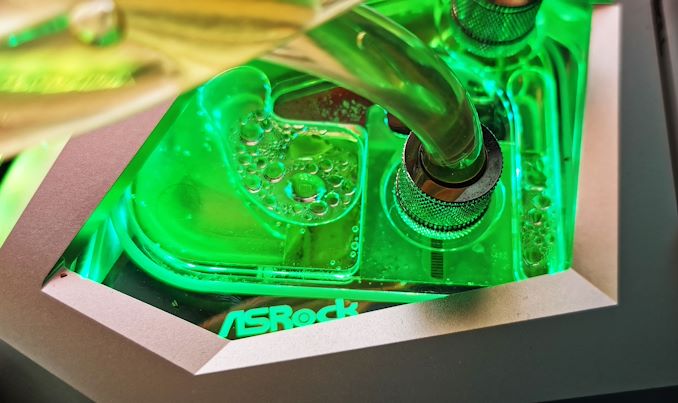
The ASRock Z490 Aqua looped up and making waves
For thermal image, we use a Flir One camera as it gives a good indication of where the heat is generated around the socket area, as some designs use different configurations and an evenly spread power delivery with good components will usually generate less heat. Manufacturers who use inefficient heatsinks and cheap out on power delivery components should run hotter than those who have invested. Of course, a $700 flagship motherboard is likely to outperform a cheaper $100 model under the same testing conditions, but it is still worth testing to see which vendors are doing things correctly.
Thermal Analysis Results

We measured 31.1°C on the hottest part of the aluminum monoblock cooling the power delivery
The ASRock Z490 Aqua is using a 16-phase power delivery which is split into fourteen power stages for the CPU which are doubled by seven ISL6617A doublers, with the other two power stages for the SoC. Across the power delivery, ASRock's power stage of choice is the Intersil ISL99390 90 A which makes up each of the boards sixteen phases. The chosen controller is the Intersil ISL69296 PWM controller which is operating in a 7+2+1 configuration.
Looking at the ASRock Z490 Aqua's power delivery thermal performance, it is aided greatly by the board's custom monoblock which cools the CPU, the power delivery, and the chipset. In our CPU overclocking, we noticed improved temperatures when comparing our Corsair HydroX 360 mm custom loop compared to the NZXT Z73 360 mm we have used for previous reviews. Looking at the figures, the ASRock Z490 Aqua power delivery topped out at 40°C on the board's integrated sensor, while our pair of thermal probes gave us a reading of 42 and 43°C respectively.
Using our FLIR thermal imaging camera, it isn't going to be as accurate as other models due to the large swathes of aluminum plating on the surface, but the reading of between 30 and 31°C we saw on the surface matched up with my IR thermometer. This puts the ASRock Z490 Aqua in a very good light, and ultimately, but yet expected, the board's large over-geared 14-phase power delivery for the CPU runs super cool.
Conclusion: Is $1100 Too Much? Most Likely
The Z490 Aqua is ASRock's second iteration of the Aqua generation, this time for Intel. It is hard to get around that price - the daunting $1100 MSRP is a little hard to stomach unless you are a user/OEM with a purpose. But the Z490 Aqua, in my opinion, is one of the most beautiful and elegantly styled motherboards I've ever seen.
The multiple aluminum panels cover at least 75% of the boards PCB, with the big custom monoblock designed to keep both the CPU and power delivery cool. That's the aim of the game here for ASRock: cool 😎. With Intel's Comet Lake desktop processors running at high temperatures, the Aqua is an expensive, albeit a solid offering for users that play with custom water coolers and enthusiasts with deep pockets.
Some of the Aqua's biggest features include an Intel Titan Ridge Thunderbolt 3 controller, which adds two Type-C and two mini DisplayPort inputs on the rear panel, with USB 3.2 Gen 2 10 Gbps support as well. This is in addition to the single USB 3.2 G2 Type-C, three USB 3.2 G2 Type-A, and four USB 3.2 G1 Type-A ports. The boards networking array is also solid with an Aquantia AQC107 10 GbE and Realtek RTL8125BG 2.5 GbE Ethernet controller pairing and Intel's AX201 Wi-Fi 6 CNVI, which also includes support for BT 5.1 devices. The board's four memory slots can accommodate up to 128 GB. Although official memory support is limited to DDR4-4700, which is lower than some of the competitor's models, it doesn't mean overclockers won't be able to push higher. Powering the audio is a premium Realtek ALC1220 HD audio codec, with an assist going to an ESS SABRE9218 DAC which boosts the front panel header's performance.
Focusing on expansion support, the Aqua has three full-length PCIe 3.0 slots which can operate at x16, x8/x8, and x8/x8/+x4. That top slot is also rated for PCIe 4.0, for when PCIe 4.0-enabled processors are launched for this platform. The Aqua has three PCIe 3.0 x4 M.2 slots, and a secret fourth they haven't listed in the specification sheet - this one says 'RKL_M2', implying extra storage capabilities for when Rocket Lake is announced.
Other storage capability includes eight SATA ports, with six of these allowing for RAID 0, 1, 5, and 10 arrays, while an ASMedia ASM1061 SATA controller controls the other two.
The Aqua is decked out in its aluminum armor, which as a very handly OLED screen which is built into the rear panel cover. This allows users to diagnose system issues, and keep track of certain elements such as fan speed, voltages, and even system and POST status. ASRock also doesn't go overkill with the integrated RGB and has three areas for users to customize, either in the firmware or with the ASRock Polychrome RGB software. Users can add even more RGB via two RGB LED, and two addressable RGB headers, for that extra bit of rainbow-inspired pizzazz.
Users looking to utilize the Aqua will need a custom water cooling loop, and our Corsair HydroX setup makes the Aqua as competitive as any other board in testing. The biggest win comes in DPC latency, with the lowest achieved latency of any Z490 model on test, with competitive performance in our computational and gaming benchmarks. Perhaps the cherry on the cake is in the power delivery thermal performance, whereas expected, the Aqua performs much better than other boards on test, with fantastic thermal dissipation properties due to the large and heavy monoblock.
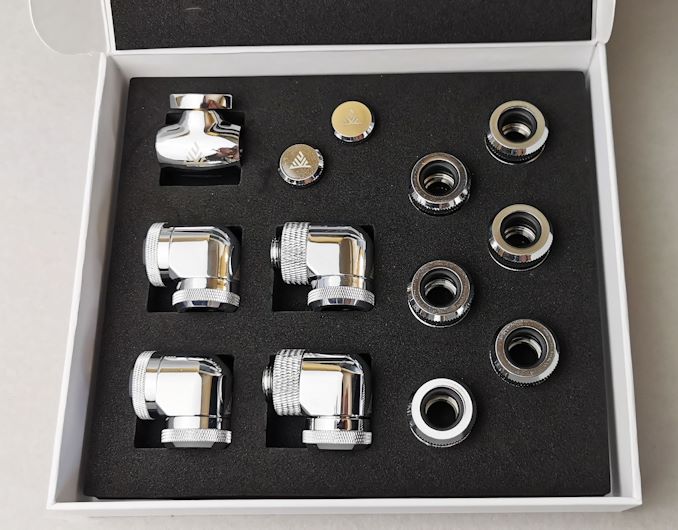
ASRock includes a custom Aqua branded fittings pack (G1/4 to 14mm OD tubing).
In our overclocking tests, we didn't manage to push our Intel Core i7-10700K beyond stable clock speeds of an all-core 5.2 GHz, but this seems to be a silicon limitation and not a thermal one. In fact, with the monoblock and the Corsair HydroX loop with a 360 mm radiator, and this was the only board on which we haven't experienced any thermal throttling with the Aqua, while we have throttling at 5.2 GHz on every other board tested with the NZXT Z73 360 mm AIO cooler. When users change the firmware's CPU VCore, it automatically sets the LLC profile to level 1, which shows in our testing with tight VDroop control from the power delivery.
Big Boards for Big Wallets
While it is unlikely users will use a motherboard such as the Aqua with anything other than Intel's Core i9-10900K or Core i9-10850K, the initial outlay for both without any extra, including water cooling gear, is going to be at least $1800. You may ask what the big deal is, but the Z490 Aqua is a limited edition model with just 999 available to the general public. While adding storage, a graphics card, and other componentry such as PSU and chassis, it's not going to be a cheap system, but the Aqua is what it is, a premium motherboard which is stacked with features.
It should be noted that the ASRock Z490 Aqua is the flagship in its Z490 product stack and actually feels premium, which in contrast to the ASRock X570 Aqua, which is very similar to its own X570 Creator at nearly half the price. You won't find many boards with all the bells and whistles in the Z490 product stack with a monoblock. However, the GIGABYTE Z490 Aorus Xtreme WaterForce is another formidable option, although at a slightly more expensive price point with its $1299 price tag.
Users may ask if it is worth the hassle - for $1800 on a CPU and a motherboard, then a good X570 paired with the 16-core Ryzen 9 3950X is still a lot cheaper than this, and users will get double the cores. Ultimately this board seems to be focused for ASRock's partners rather than anything else - building pimped out systems to show off design ideas, hardware, and showcase at events (even if events aren't going on right now). For the bottomless pocket users too, OEMs are the places that will build these systems for retail. Casual builders need not bother looking at this price segment, if only gawp in wonder.
Nonetheless, the ASRock Z490 Aqua is a fine example of ASRock's engineering and desire to raise other vendors' stakes to compete within this small market segment. It's one of those models that either win you over at first sight, or not, but the added Aqua branded water cooling fittings in the accessories is a nice touch, which should have been present X570 Aqua's packaging. ASRock is known for trying some of the more esoteric ideas in motherboards, and iterating on the Aqua design is certainly an interesting route to go down.

